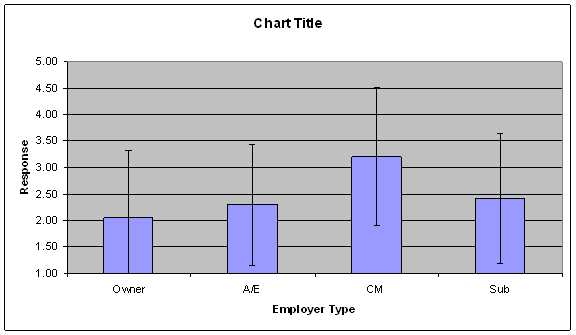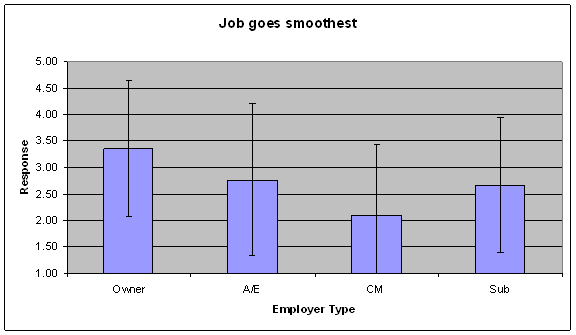
Owner Presence on the Job
A strong owner presence on the job is desirable, if it aids decision making.
Summary
CMs are about neutral about having an Owner’s representative on the job site, but A/Es and Subs favor having one. This may relate to the having a decision maker on the job site.
Report
During construction the role of the Owner’s representative may cause tension. The CM is responsible for supervising the work, but the Owner representative has a lot of clout and might interfere, on purpose or by accident, with the CM’s authority on the job site.
So, so we asked about activities of the owner (other than inspection/QA/QC). First, “A prudent owner should have a middle-management level manager on the job at least part of each day because there are important issues of coordination with other activities of the owner, scheduling and phases, inherent complexity of the project, myriad other issue with the users, there are often many coordination issues. Score 1-5, where 1 means strongly agree and 5 means strongly disagree.”

By employer, there was an almost significant trend. CMs at 3.2 disagreed mildly while others Owner and A/E agreed more, 2.05 and 2.29. The differences between CM and the Owner, A/E and Subs were significant. There was no trend by CMAR experience. Note that CMs don’t vehemently disagree with having the Owner’s rep on the site each day; they are almost neutral on the point. While ego might be threatened that the Owner will kibitz or give directions to Subs or find fault, the CM often needs decisions from the Owner. Thus having the Owner on the site might be perceived as a benefit. Hence on the average, the CMs don’t mind have the Owner on the job often. The A/E and Subs may feels it’s a good idea to help with decisions, but don’t feel an ego threat from the Owner’s presence. Hence the A/Es and Subs, on the average, agree more.
The second question tests the opposite, “The job goes smoothest if the owner’s manager only visits the job as occasion warrants and leaves all the day-to-day jobsite oversight to the CM.” Score 1-5, where 1 means strongly agree and 5 means strongly disagree.

Observation
Almost significant trend, Owner 3.36 expressing mild disagreement and CMs at 2.1 expressing agreement. The differences between those two was significant. The differences between the Subs and A/E with the CM are almost significant. There was no trend by CMAR experience.
This question might have been pejorative towards Owners – implying that things are better when they don’t come around. Note though that CMs agreed more than Subs or the A/E, that is Subs and the A/E are comfortable with more Owner presence. This is similar to their responses above.
This comment may hold a key to explaining this result. “With close to 30 years in the subcontractor market, both in the field and management, it is my opinion that the CM projects with the highest degree of success for both the Owner and contractors all have one thing in common. The Owner’s representative has to have the power to exercise his decisions. When the Owner appoints a rep he needs to report to the Owner’s president or CEO. This enables him to make a decision without the fear of losing his job or getting mired in the muck of interoffice politics. This lack of indecision from the very top is what creates the very first step of efficiency and in the end will bring a project in under budget and ahead of schedule. Every job with a Owner’s “team” has been extremely cumbersome.”
Another aspect of this might be that the CMs prefer being the point of contact with the Owner, while the A/Es and Subs would like to be involved directly with the Owner, if the matter is important. My take is that the data support some discomfort by the CM of having the Owner’s rep on the site, but this is balance if the Owner’s rep can make decisions.